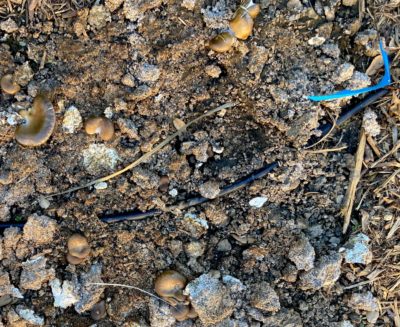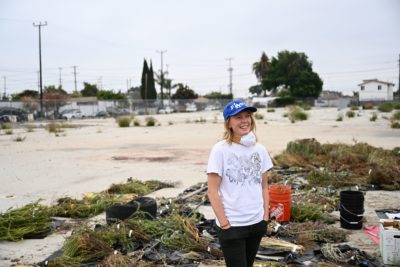There are about a million brownfield sites — industrial and commercial sites contaminated with hazardous substances — scattered across the U.S. According to the Environmental Protection Agency, these sites are disproportionately concentrated near low-income neighborhoods and communities of color, and researchers predict that heavier rains and flooding caused by climate change are likely to spread these pollutants and increase exposure.
For over 15 years, Daniel Stevenson, who received his PhD in Environmental Toxicology from the University of California, Riverside, has been pioneering nature-based techniques that use fungi and native plants to break down toxins such as oil, plastics and pesticides into less toxic chemicals and remediate contaminated land.
The usual way to deal with contaminated soil is to dig it up and transport it to a distant landfill, but that’s expensive and just shifts the problem elsewhere, Stevenson said in an interview. Yale Environment 360“Usually to another state that has less regulated waste disposal laws.”
In a recent pilot project funded by the city of Los Angeles, Stevenson, 37, worked with a team of students from the University of California, Riverside and other volunteers to significantly reduce petrochemical pollutants and heavy metals at abandoned rail yards and other industrial sites in Los Angeles. Though the research is still in its early stages, Stevenson believes that if scaled up, the bioremediation method could be used to clean up contaminated land around the world.
California buckwheat has absorbed lead from contaminated sites in Los Angeles.
Patrick T. Fallon/AFP via Getty Images
Yale Environment 360: I understand you grew up in a very polluted area on Lake Erie.
Daniel Stevenson: The Cuyahoga River near Lake Erie has previously burned due to oil spills, and large amounts of industrial agricultural runoff have caused toxic algae blooms. The second-largest floating plastic island in the Great Lakes is located in Lake Erie.
But I was amazed to see trees, plants and mushrooms growing in abandoned oil refineries and factories. Fungi were found growing in the area where the Chernobyl reactor melted down. I’ve been to places where the air smells of diesel and it’s stark and desolate. It looks like nothing can live there. But when you take soil samples, you always find life, especially fungi that are very resilient and have found a way to live in those environments and get some food out of the pollutants.
360: No So you got interested in fungi and eventually founded a fungus remediation company. DIY FungiWhat are fungi?
Stevenson: They have their own kingdom of life: they are not bacteria, nor are they a type of plant or animal: some fungi form mushrooms. [as their fruiting bodies]like the mushrooms we love to eat. Other fungi don’t form mushrooms, but instead form beautiful, dynamic networks that connect plant roots throughout forests and grasslands. Fungi are a largely overlooked but incredibly important kingdom without them we wouldn’t have soils, carbon cycles, and many other vital ecosystem functions.
“Within three months, all contaminants were reduced by more than 50 percent. After 12 months, they were barely detectable.”
360: No How can fungi help remediate contaminated soil?
Stevenson: Decomposers can break down petrochemicals in the same way they break down dead wood, and in doing so, they reduce the toxicity of the petrochemicals, creating soil that is free of pollutants or has significantly reduced levels of pollutants. Decomposers can also eat other things made from petroleum, such as plastics and pesticides.
360: No They are not picky eaters.
Stevenson: They would probably want to eat cellulose, which is the raw material of plants, but if cellulose isn’t there and instead you have diesel fuel or something that’s essentially carbon, they’ll find a way to eat it and get their enzymes to work on it in the same way they would with cellulose.
360: No You worked at an industrial site in Los Angeles that was highly contaminated with heavy metals, how did fungi help there?
Stevenson: Unfortunately, most metals don’t break down because they’re not carbon-based. In nature, it’s plants that pull the metals out of the soil, and fungi called arbuscular mycorrhizal fungi help the plants break them down. Taylor Yard [the Los Angeles railyard] And in other places, we’ve been working with a combination of decomposer fungi, arbuscular mycorrhizal fungi, and plants that we’ve previously found can pull metals like lead and arsenic out of the soil and above ground, so that they can be removed from the site without having to remove all of the contaminated soil.

Mushrooms growing on a brownfield in Los Angeles.
Daniel Stevenson
360: No How has the site changed since you did the work?
Stevenson: It’s now a beautiful, flowering native meadow, and now all kinds of creatures are coming, including bees and birds. We’ve had a very high success rate, with over a 50% reduction in population in three months. [petrochemical] It’s a contaminant. And after 12 months it was barely detectable.
360: No These sites had native plants that absorbed a lot of the lead and other metals that were contaminating the soil, but the plants themselves became toxic, right? So they were just left there?
Stevenson: No, they harvest them. Large amounts of biomass containing these metals can be harvested and either incinerated to produce a small amount of ash or a sludge containing concentrated metals that can then be disposed of as hazardous waste or reused. In some cases, the precious metals can be extracted and used in batteries and electronics.
360: No The usual way to deal with toxic soil is called “dig and dump” – digging it up and moving it somewhere else. Why isn’t that the best option?
Stevenson: It’s expensive – millions of dollars per site – so contaminated sites are left uncleaned across the country for decades. What’s more, the problem isn’t solved – it simply migrates somewhere else, usually to a state with weaker dumping regulations. Along the way, it spreads huge amounts of toxic dust, [all that trucking] Emissions contribute to climate change.
“People who live in areas affected by contamination need to have a say in how their neighborhoods are cleaned up.”
360: No You don’t just deal with contaminated soil. You were also invited to a bike shop to help them process their waste lubricants. How was that?
Stevenson: They showed us piles of garbage bags filled with rags soaked in lubricant, all of which is headed to landfills. Bike lubricant is made from petrochemicals, [including] Teflon is a permanent chemical, the same one used in frying pans. It is highly toxic and permanent.
I inoculated some lubricant-soaked rags with the fungus spores. The rags themselves are often made of plant fibers or plastic fibers like polyester, so I knew they would be edible for the fungus, too. So I covered them with cardboard I bought at a bike store. I then added earthworms, who continued the decomposition process by turning the mycelium clumps on the rags into soil.
360: No So this pilot project was a two-step process – it starts with the mycelium, digestion begins, and the worms complete the digestion – is this something other bike shops could start doing on their own?
Stevenson: I’m actually working with a really great bike shop in LA right now, and we just need the funding to actually test the system. The whole design is done, and we’ve been iterating on it and it’s gotten a lot better. I think it’s super cool.

Stevenson at a cleanup site in Los Angeles.
Patrick T. Fallon/AFP via Getty Images
360: No You say that using fungi and plants to treat pollutants is much cheaper than other ways of dealing with the problem, so why don’t we do more of it? Is it that we just don’t know enough about it yet?
Stevenson: There have been scaling issues, and I’ve been working with not just academia but with industry, regulators, and governments on scaling, and there are a lot of regulatory barriers, and even funding barriers, to testing some of these so-called new methods.
360: No I have heard that they are also running training programs for indigenous people so that they can begin restoration work themselves. [on tribal lands]Instead of bringing in outsiders, we work with youth programs and environmental justice communities to help them clean up their own communities.
Stevenson: There are a number of sacred sites that I have worked on at the invitation of several tribes who want to study bioremediation. [these communities] People feel like they’re not being listened to, so I bring in the science that basically confirms what people already know and affirms nature’s ability to heal itself. I’m saying the same things they are saying, but in scientific language that regulators and other groups can easily listen to.
People who live in areas affected by contamination need to have a say in how their communities are cleaned up. They need to be given the tools to do so. That’s why I’ve been doing these studies and pilot projects, as well as implementing workforce development programs, potentially creating economic opportunities and benefits for communities beyond just cleaning up contaminated sites.
This interview has been edited for length and clarity.







